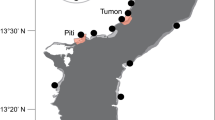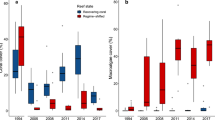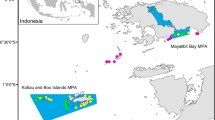Abstract
It has become almost paradigmatic in the coral reef literature that fishing-induced reductions of parrotfish abundance cause benthic phase shifts from coral to macroalgal dominance. This study examined the alternatives of top-down control of the benthos by parrotfish density and bottom-up control of parrotfish density by the benthos at four Philippine islands in a long-term (7.5–30 years) “natural experiment”. No-take marine reserves (NTMRs) demonstrated that fishing reduced parrotfish density significantly at two islands (Sumilon, Mantigue), but not significantly at two other islands (Apo, Selinog). There was no evidence that cover of hard coral decreased, nor macroalgal cover increased, in fished areas relative to NTMRs, no evidence that parrotfish density affected hard coral cover significantly, and thus no evidence of top-down, fishing-induced benthic phase shifts at all four islands. There was, however, compelling evidence that benthos (cover of dead substrata and hard coral) exerted strong bottom-up control on parrotfish density. This bottom-up control was demonstrated most clearly by major environmental disturbances (e.g. typhoons, coral bleaching) that changed benthic habitat and, subsequently, parrotfish density. As hard coral cover declined (and cover of dead substratum increased), parrotfish density increased and vice versa. This response occurred in both major parrotfish feeding guilds (scrapers and excavators). This long-term study on heavily fished coral reefs suggests that the benthos drives the parrotfish, not the other way around. The paradigm of fishing-induced benthic phase shifts may not apply to all coral reefs at all times. Multiple drivers of benthic change on coral reefs should always be considered.







Similar content being viewed by others
References
Adam TC, Burkepile DE, Ruttenberg BI, Paddack MJ (2015) Herbivory and the resilience of Caribbean coral reefs: knowledge gaps and implications for management. Mar Ecol Prog Ser 520:1–20
Alcala AC, Russ GR (2002) Status of Philippine coral reef fisheries. Asian Fish Sci 15:177–192
Alcala AC, Russ GR (2006) No-take marine reserves and reef fisheries management in the Philippines: a new people power revolution. Ambio 35:245–254
Arceo HO, Quibilan MC, Alino PM, Lim G, Licuanan WY (2001) Coral bleaching in Philippine reefs: coincident evidences with mesoscale thermal anomalies. Bull Mar Sci 69:579–593
Aronson RB, Precht WF (2006) Conservation, precaution, and Caribbean reefs. Coral Reefs 25:441–450
Babcock RC, Shears NT, Alcala AC, Barrett NS, Edgar GJ, Lafferty KD, McClanahan TR, Russ GR (2010) Decadal trends in marine reserves reveal differential rates of change in direct and indirect effects. Proc Nat Acad Sci 107:18256–18261
Bellwood DR, Hughes TP, Folke C, Nyström M (2004) Confronting the coral reef crisis. Nature 429:827–833
Bohnsack JA, Harper DE, McClellan DB, Kellison GT, Ault JS, Smith SG, Zurcher N (2009) Coral reef fish response to FKNMS management zones: the first ten years (1997–2007). Progress report to the Florida keys national marine sanctuary, PRBD 08/09–10 10 June 2009
Bonaldo RM, Hoey AS, Bellwood DR (2014) The ecosystem roles of parrotfishes on tropical reefs. Ocean Mar Biol Ann Rev 52:81–132
Bruggemann JH, Kuyper MWM, Breeman AM (1994) Comparative analysis of foraging and habitat use of the sympatric Caribbean parrotfish Scarus vetula and Sparisoma viride (Scaridae). Mar Ecol Prog Ser 112:51–66
Bruno JF, Sweatman H, Precht WF, Selig ER, Schutte VG (2009) Assessing evidence of phase shifts from coral to macroalgal dominance on coral reefs. Ecol 90:1478–1484
Burkepile DE, Hay ME (2008) Herbivore richness and feeding complementarity affect community structure and function on a coral reef. Proc Nat Acad Sci 105:16201–16206
Carassou L, Le´opold M, Guillemot N, Wantiez L, Kulbicki M (2013) Does herbivorous fish protection really improve coral reef resilience? Study from New Caledonia (South Pacific). PLoS One 8:e60564
Carpenter K, Abrar M, Aeby G, Aronson RB, Banks S, Bruckner A, Chiriboga A, Cortes J, Delbeel C, De Vantier L et al (2008) One-third of reef-building corals face elevated extinction risk from climate change and local impacts. Science 321:560–563
Cheal AJ, MacNeil MA, Cripps E, Emslie MJ, Jonker M, Schaffelke B, Sweatman HPA (2010) Coral-macroalgal phase shifts or reef resilience: links with diversity and functional roles of herbivorous fishes on the Great Barrier Reef. Coral Reefs 29:1005–1015
Cheal AJ, Emslie MJ, Miller I, Sweatman HPA (2012) The distribution of herbivorous fishes on the Great Barrier Reef. Mar Biol 159:1143–1154
Cheal AJ, Emslie M, MacNeil MA, Miller I, Sweatman H (2013) Spatial variation in the functional characteristics of herbivorous fish communities and the resilience of coral reefs. Ecol Appl 23:174–188
Choat JH (1991) The biology of herbivorous fishes on coral reefs. In: Sale PF (ed) The ecology of fishes on coral reefs. Academic Press, San Diego, pp 120–155
Choat JH, Clements KD, Robbins WD (2002) The trophic status of herbivorous fishes on coral reefs. I: dietary analyses. Mar Biol 140:613–623
Choat JH, Robbins WD, Clements KD (2004) The trophic status of herbivorous fishes on coral reefs. II. Food processing modes and trophodynamics. Mar Biol 145:445–454
Clements KD, Raubenheimer D, Choat JH (2009) Nutritional ecology of marine herbivorous fishes: ten years on. Funct Ecol 23:79–92
Comeros- Raynal MT, Choat JH, Polidoro BA, Clements KD, Abesamis R, Craig MT, Lazuardi ME, McIlwain J, Muljadi A, Myers RF (2012) The likelihood of extinction of iconic and dominant herbivores and detritivores of coral reefs: the parrotfishes and surgeonfishes. PLoS One 7:e39825
Cote IM, Precht WF, Aronson RB, Gardner TA (2013) Is Jamaica a good model for understanding Caribbean coral reef dynamics? Mar Pollut Bull 76:28–31
Crossman DJ, Choat JH, Clements KD (2005) Nutritional ecology of nominally herbivorous fishes on coral reefs. Mar Ecol Prog Ser 296:129–142
De’ath G, Fabricius KE, Sweatman H, Puotinen M (2012) The 27–year decline of coral cover on the Great Barrier Reef and its causes. Proc Nat Acad Sci 109:17995–17999
Edwards CB, Friedlander AM, Green AG, Hardt MJ, Sala E, Sweatman HP, Williams ID, Zgliczynski B, Sandin SA, Smith JE (2013) Global assessment of the status of coral reef herbivorous fishes: evidence for fishing effects. Proc Roy Soc B 281:20131835
Emslie MJ, Cheal AJ, Sweatman H, Delean S (2008) Recovery from disturbance of coral and reef fish communities on the Great Barrier Reef, Australia. Mar Ecol Prog Ser 371:177–190
Emslie MJ, Cheal AJ, Johns KA (2014) Retention of habitat complexity minimizes disassembly of reef fish communities following disturbance: a large-scale natural experiment. PLoS One 9:e105384
Fabricius KE (2005) Effects of terrestrial runoff on the ecology of corals and coral reefs: review and synthesis. Mar Pollut Bull 50:125–146
Graham NAJ, Wilson SK, Jennings S, Polunin NV, Bijoux JP, Robinson J (2006) Dynamic fragility of oceanic coral reef ecosystems. Proc Nat Acad Sci 103:8425–8429
Graham NAJ, Jennings S, MacNeil MA, Mouilliot D, Wilson SK (2015) Predicting climate-driven regime shifts versus rebound potential in coral reefs. Nature 518:94–97
Hairston NG, Smith FE, Slobodkin LB (1960) Community structure, population control, and competition. Am Nat 94:421–425
Hodgson G, Dixon JA (2000) El Nido revisited: ecotourism, logging and fisheries. In: Cesar H (ed) Collected essays on the economics of coral reefs. CORDIO, Kalmar University, Sweden, pp 55–68
Hoegh-Guldberg O, Mumby PJ, Hooten AJ, Steneck RS, Greenfield P, Gomez E et al (2007) Coral reefs under rapid climate change and ocean acidification. Science 318:1737–1742
Hughes TP (1994) Catastrophes, phase-shifts, and large-scale degradation of a Caribbean coral reef. Science 265:1547–1551
Hughes TP, Bellwood DR, Folke CS, McCook LJ, Pandolfi JM (2007) No-take areas, herbivory and coral reef resilience. Trends Ecol Evol 22:1–3
Hughes TP, Graham NAJ, Jackson JB, Mumby PJ, Steneck RS (2010) Rising to the challenge of sustaining coral reef resilience. Trend Ecol Evol 25:633–642
Hunter MD, Price PW (1992) Playing chutes and ladders: heterogeneity and the relative roles of bottom-up and top-down forces in natural communities. Ecol 73:724–732
Jackson JBC, Donovan MK, Cramer KL, Lam VV (eds) (2014) Status and trends of Caribbean coral reefs: 1970–2012. Global Coral Reef Monitoring Network, IUCN, Gland
Kamp-Nielsen L, Vermaat JE, Wesseling I, Borum J, Geertz-Hansen O (2002) Sediment properties along gradients of siltation in South-east Asia. Estuar Coast Shelf Sci 54:127–137
McClanahan TR (1994) Kenyan coral reef lagoon fish: effects of fishing, substrate complexity, and sea urchins. Coral Reefs 13:231–241
McClanahan TR (2014) Recovery of functional groups and trophic relationships in tropical fisheries closures. Mar Ecol Prog Ser 497:12–23
McClanahan TR, Graham NAJ, Calnan JM, MacNeil MA (2007) Toward pristine biomass: reef fish recovery in coral reef marine protected areas in Kenya. Ecol Appl 17:1055–1067
McClanahan TR, Graham NAJ, MacNeil MA, Muthiga MA, Cinner JE, Bruggerman JH, Wilson SK (2011a) Critical thresholds and tangible targets for ecosystem-based management of coral reef fisheries. Proc Nat Acad Sci 108:17230–17233
McClanahan TR, Muthiga NA, Coleman R (2011b) Testing for top-down control: can post-disturbance fisheries closures reverse algal dominance? Aquat Conserv Mar Freshw Ecosyst 21:658–675
McCook L, Jompa J, Diaz-Pulido G (2001) Competition between corals and algae on coral reefs: a review of evidence and mechanisms. Coral Reefs 19:400–417
Menge BA (2000) Top-down and bottom-up community regulation in marine rocky intertidal habitats. J Exp Mar Biol Ecol 250:257–289
Mumby PJ, Harborne AR (2010) Marine reserves enhance the recovery of corals on Caribbean Reefs. PLoS One 5:e8657
Mumby PJ, Steneck RS (2008) Coral reef management and conservation in light of rapidly evolving ecological paradigms. Trends Ecol Evol 23:555–563
Mumby PJ, Dahlgren CP, Harborne AR, Kappel CV, Micheli F, Brumbaugh DR, Holmes KE, Mendes JM, Broad K, Sanchirico JN, Buch K, Box S, Stoffle RW, Gill AB (2006) Fishing, trophic cascades, and the process of grazing on coral reefs. Science 311:98–101
Newton K, Cote IM, Pilling GM, Jennings S, Dulvy NK (2007) Current and future sustainability of island coral reef fisheries. Curr Biol 17:655–658
Pratchett MS, Munday P, Wilson SK, Graham NA, Cinner JE, Bellwood DR, Jones GP, Polunin NV, McClanahan TR (2008) Effects of climate-induced coral bleaching on coral-reef fishes. Ecological and economic consequences. Oceanogr Mar Biol Ann Rev 46:251–296
R Core Team (2012) R: a language and environment for statistical computing. R Foundation for Statistical Computing, Vienna, Austria. ISBN 3-900051-07-0. http://www.R-project.org/Raimondi
Rasher DB, Hoey AS, Hay ME (2013) Consumer diversity interacts with prey defenses to drive ecosystem function. Ecol 94:1347–1358
Roff G, Mumby PJ (2012) Global disparity in the resilience of coral reefs. TREE 27:404–413
Russ G (1984) Distribution and abundance of herbivorous grazing fishes in the central Great Barrier Reef. II: patterns of zonation of mid-shelf and outer-shelf reefs. Mar Ecol Prog Ser 20:35–44
Russ GR, Alcala AC (1998) Natural fishing experiments in marine reserves 1983–1993: roles of life history and fishing intensity in family responses. Coral Reefs 17:399–416
Russ GR, Stockwell B, Alcala AC (2005) Inferring versus measuring rates of recovery in no-take marine reserves. Mar Ecol Prog Ser 292:1–12
Russ GR, Bergseth BJ, Rizzari JR, Alcala AC (2015) Decadal-scale effects of benthic habitat and marine reserve protection on Philippine goatfish (F. Mullidae). Coral Reefs 34:773–787
Scheffer M, Barrett S, Carpenter SR, Folke C, Green AJ, Holmgren M, Hughes TP, Kosten S, van de Leemput A, Nepstad DC, Peeters ETH, Walker B (2015) Creating a safe operating space for iconic ecosystems. Science 347:1317–1319
Selig ER, Bruno JF (2010) A global analysis of the effectiveness of marine protected areas in preventing coral loss. PLoS One 5:e9278
Smith JE, Hunter CL, Smith CM (2010) The effects of top-down versus bottom-up control on benthic coral reef community structure. Oecologia 163:497–507
Smith SG, Ault JS, Bohnsack JA, Harper DE, Luo J, McClellan DB (2011) Multispecies survey design for assessing reef-fish stocks, spatially explicit management performance, and ecosystem condition. Fish Res 109:25–41
Spalding MD, Ravilious C, Green EP (2001) World atlas of coral reefs. University of California Press, Berkeley
Stockwell B, Jadloc CRL, Abesamis RA, Alcala AC, Russ GR (2009) Trophic and benthic responses to no-take marine reserve protection in the Philippines. Mar Ecol Prog Ser 389:1–15
Taylor BT, Lindfield SJ, Choat JH (2014) Hierarchical and scale-dependent effects of fishing pressure and environment on the structure and size distribution of parrotfish communities. Ecography 37:1–11
Toth LT, van Woesik R, Murdoch TJT, Smith SR, Ogden JC, Precht WF, Aronson RB (2014) Do no-take reserves benefit Florida’s corals? 14 years of change and stasis in the Florida Keys National Marine Sanctuary. Coral Reefs 33:565–577
Tredennick H (1954) The last days of Socrates in Tredennick. Penguin Books Ltd., England
Tzadik OE, Appeldoorn RS (2013) Reef structure drives parrotfish species composition on shelf edge reefs in La Parguera, Puerto Rico. Cont Shelf Res 54:14–23
Wilson SK, Graham NAJ, Pratchett MS, Jones GP, Polunin NV (2006) Multiple disturbances and the global degradation of coral reefs: are reef fishes at risk or resilient? Glob Change Biol 12:2220–2234
Wilson SK, Fisher R, Pratchett MS, Graham NAJ, Dulvy NK, Turner RA, Cakacaka A, Polunin NVC, Rushton SP (2008) Exploitation and habitat degradation as agents of change within coral reef fish communities. Glob Change Biol 14:2796–2809
Acknowledgments
This research was supported by the Australian Research Council (ARC) Centre of Excellence for Coral Reef Studies and the College of Marine and Environmental Sciences at James Cook University, and a Pew Fellowship to GR Russ and AC Alcala (1999–2002). Thanks to R. A. Abesamis, J. H. Choat, RM Bonaldo and one anonymous reviewer for very helpful comments on the manuscript.
Author information
Authors and Affiliations
Corresponding author
Additional information
Responsible Editor: K.D. Clements.
Reviewed by R. Bonaldo and an undisclosed expert.
Garry R. Russ and Sarah-Lee A. Questel have contributed equally to this work.
Electronic supplementary material
Below is the link to the electronic supplementary material.
Rights and permissions
About this article
Cite this article
Russ, G.R., Questel, SL.A., Rizzari, J.R. et al. The parrotfish–coral relationship: refuting the ubiquity of a prevailing paradigm. Mar Biol 162, 2029–2045 (2015). https://doi.org/10.1007/s00227-015-2728-3
Received:
Accepted:
Published:
Issue Date:
DOI: https://doi.org/10.1007/s00227-015-2728-3




